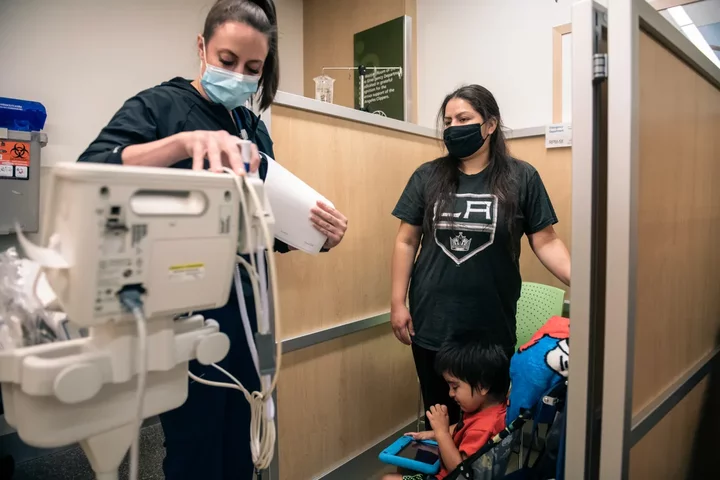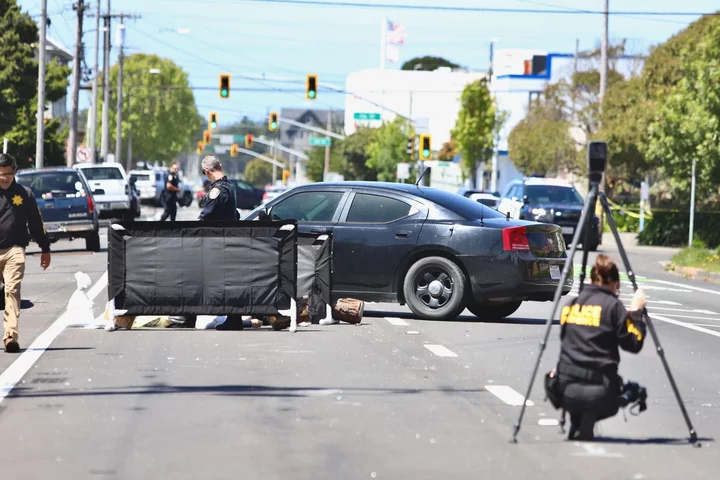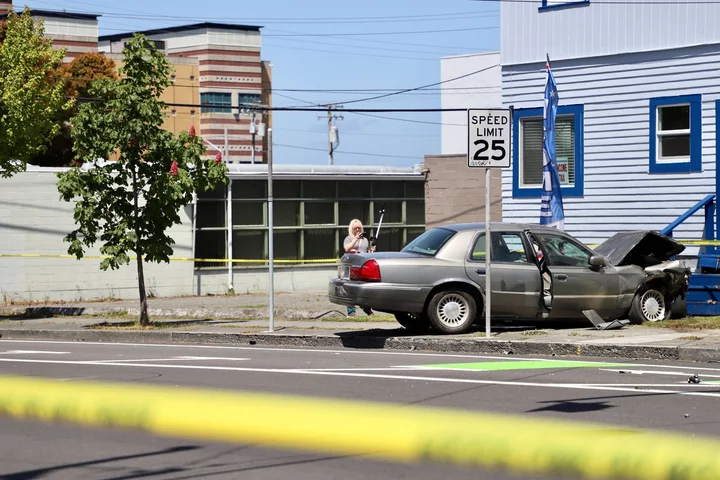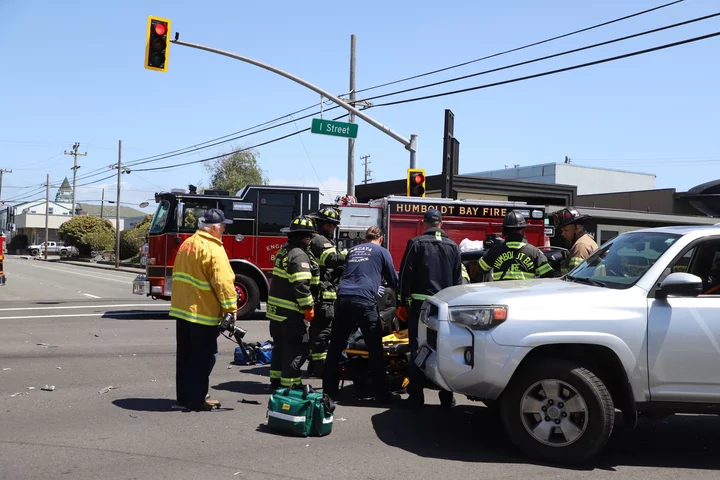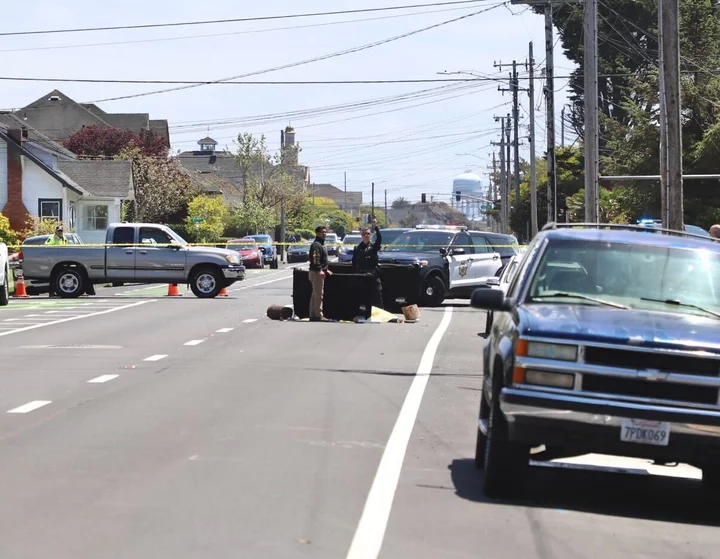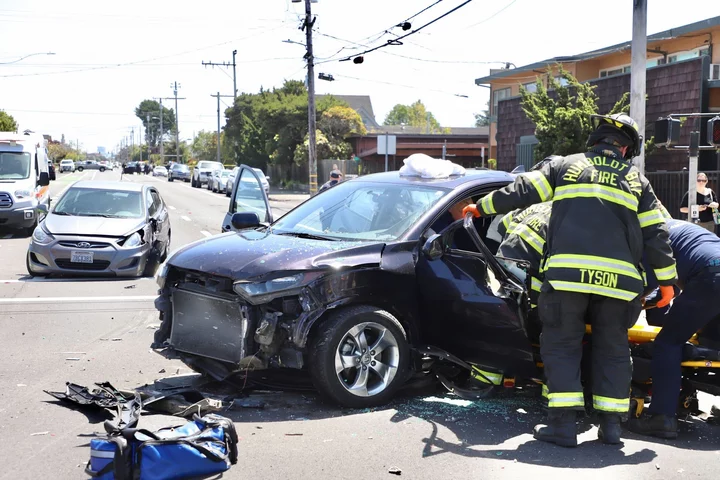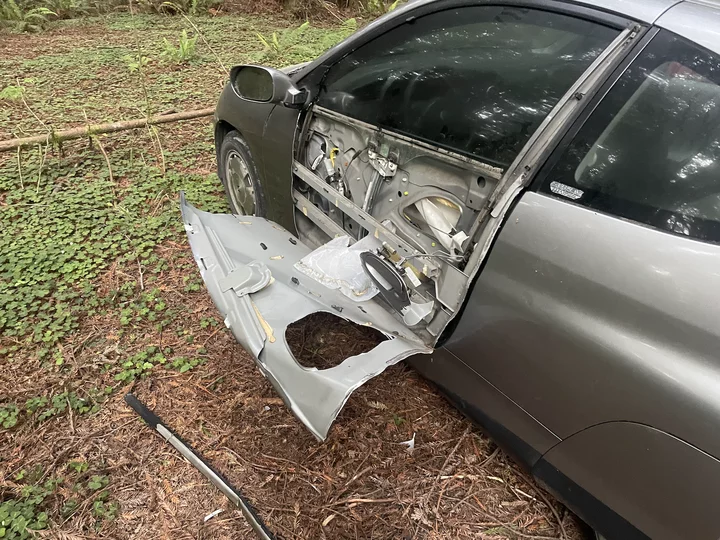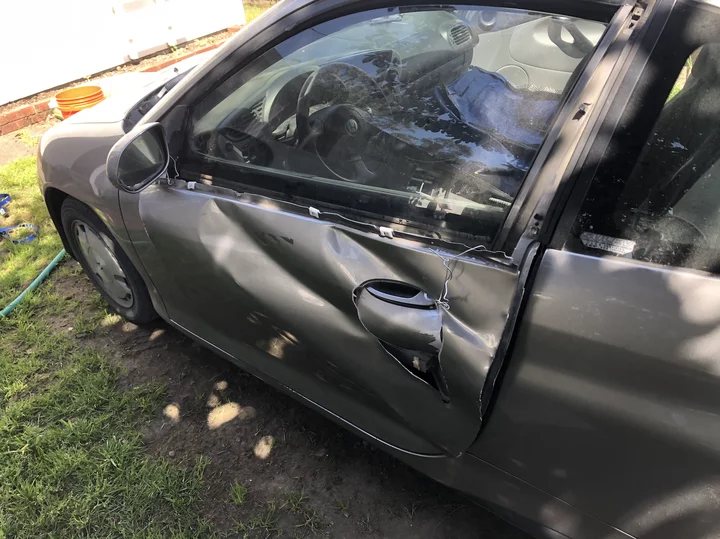California Climate Programs Would Lose Billions in Newsom’s Budget
Alejandro Lazo / Thursday, May 23, 2024 @ 7:43 a.m. / Sacramento
Democratic lawmakers and environmental advocates are urging Gov. Gavin Newsom to support a bond measure to help pay for billions of dollars in climate programs endangered by the state’s record deficit and deepening budget cuts.
The lobbying comes as an array of key climate programs — including efforts to combat rising seas and help low-income Californians buy electric cars — face significant cuts and delays as California seeks to close a $56 billion deficit over the next two fiscal years.
The governor and the Legislature two years ago approved a $54.3 billion spending package for what he called his “California Climate Commitment.” After a round of trims last year, Newsom in January proposed an additional $2.8 billion in cuts, or 7%, this year. Then, earlier this month, he proposed more than doubling that amount by adding another $3.3 billion in funding cuts. In all, that is a 17% reduction, or $9.4 billion, from the 2022 peak.
The governor also has proposed delaying the funding of some of the state’s programs.
For instance, the Clean Cars for All program, which helps lower-income Californians replace their older gas-powered cars, was slated to get $45 million next year, but Newsom has suggested delaying that money until the 2027-28 fiscal year. He will be termed out of office by then. The program received $611 million in one-time funding in the 2021 through 2023 budgets but it has not all been allocated yet.
Climate and public health advocates say cutting or delaying spending on programs that reduce greenhouse gases or help California adapt to climate change will exacerbate natural disasters and weather emergencies and allow air pollution to continue for years to come.
California’s climate spending includes programs to enhance coastal resilience as sea levels rise, prepare for wildfires, ensure water security and develop solar and wind energy projects.
Advocates are raising the alarm about reductions in “resiliency” programs meant to help California adapt to climate change, particularly sea-level rise and extreme heat. The Coastal Commission, for instance, is facing $392 million in cuts for various coastal programs, according to a state Assembly committee summary.
“The climate crisis doesn’t take a break for tough budget years,” said David Weiskopf, senior policy advisor for NextGen California, which advocates for environmental and social issues. “Anything we put off for later will only cost us more and run up the bill we will have to pay as the climate crisis worsens.”
“The climate crisis doesn’t take a break for tough budget years. Anything we put off for later will only cost us more … as the climate crisis worsens.”
— David Weiskopf, NextGen California
The Senate and the Assembly have passed competing measures that would seek voter approval in November for a bond to pay for climate programs. Newsom has not endorsed either of them.
The tough budget choices come after the state budget ballooned with record surpluses after the COVID-19 pandemic, buoyed by an influx of federal spending, a soaring stock market and higher earnings, particularly for high-income Californians.
Newsom saw that windfall as an opportunity to shore up a state reeling from calamitous wildfires, droughts and floods. In 2021 he began setting aside two consecutive years of surplus to combat climate change, but then began cutting back last year.
Now, facing the large deficit, Newsom said he would rather not eliminate or scale back climate programs that he supported. Earlier this month, Newsom said the 83% of the climate funding that he is proposing keeping intact is significant.
“There (are) no material cuts to the climate agenda,” Newsom said during a May 10 press conference. “There was a lot of creativity.”
But environmental advocates disagree, saying that the cuts will affect California’s efforts to fight the effects of a warming planet.
“There (are) no material cuts to the climate agenda…There was a lot of creativity.”
— Gov. Gavin Newsom
California is already in danger of failing to meet its ambitious goals unless it almost triples its rate of reducing greenhouse gases through 2030, according to recent analysis. If the state has to scale back programs aimed at reducing emission, those goals may become harder to meet.
“It’s very fair to say we’re slowing down California’s transition to its climate goals and its clean energy goals,” said Barry Vesser, chief operating officer of The Climate Center, an advocacy group. “Unfortunately, as you and I know, physics and chemistry and climate change do not really care about the state’s fiscal condition.”
Facing a June 15 deadline to pass a revised budget, legislators are pressing for a bond measure that would fund some of those programs.
Assemblymember Eduardo Garcia, a Democrat from Coachella and author of the Assembly’s bond bill, AB 1567, said “advancing a climate bond offers a can’t-miss opportunity to alleviate funding disparities while making the investments we need to protect” Californians from climate change. Sen. Ben Allen, a Democrat from El Segundo, author of the Senate’s bond proposal, SB 867, said in a statement that California “urgently needs to invest in solutions to mitigate the worst impacts of climate change.”
At the press conference, Newsom would only say that “we’re maintaining a posture of engagement” on a climate bond.
He said he is wary of another bond measure after suffering a ballot box setback in March, when voters approved his $6.4 billion mental health bond by the slimmest of margins, 50.2% to 49.8%. That experience, Newsom said during his press conference, “sobered, I think, a lot of the conversation up here.”
“The public wants to see results,” the governor told reporters. “They are not interested in inputs, they are not interested to talk about how much money we’re spending.”
Jon Coupal, president of the Howard Jarvis Taxpayers Association, said he was wary of bonds that might pay for climate programs, especially if those programs don’t pan out.
“Are they really going to create those kinds of projects with a long-term benefit?” he asked.
On Wednesday, the state budget committee overseeing climate programs delved into the governor’s proposal in detail. Assemblymember Steve Bennett, a Democrat from Oxford and chair of the committee, said he hopes to avoid some of the reductions.
“I will continue to fight for maintaining and restoring funding for wildfire preservation, water resilience, sustainable agriculture and environmental justice within the bounds of the budget constraints that we have,” Bennett said. “Given this budget shortfall, and our current fiscal reality, for every dollar we try to restore, we have to cut somewhere else.”
Newsom is increasingly relying on the state’s cap-and-trade program — the market for companies buying and selling greenhouse gas credits — to make good on his previous spending commitments. He is proposing funding $5.2 billion of his climate agenda from cap and trade’s Greenhouse Gas Reduction Fund.
Environmental justice advocates oppose the cap and trade program because it allows pollution from some facilities to continue, largely in the state’s poorest communities.
The Lung Association recently identified California as home to six of the 10 smoggiest cities in the country. Vehicles are the primary source of the state’s smog, and delays in the funding of low-emission programs such as the clean car rebates will undermine the state’s efforts to clean the air, said Will Barrett, a senior director with the American Lung Association.
“These are programs intended to reduce harmful pollution,” Barrett said. “To the extent that these resources are taken away from those purposes, that’s obviously concerning.”
###
The CalMatters Ideas Festival takes place June 5-6! Find out more and get your tickets at this link.
CalMatters.org is a nonprofit, nonpartisan media venture explaining California policies and politics.
BOOKED
Today: 12 felonies, 20 misdemeanors, 0 infractions
JUDGED
Humboldt County Superior Court Calendar: Friday, Jan. 9
CHP REPORTS
2542 Quinlan Ave (HM office): Traffic Hazard
Sr255 / V St (HM office): Live or Dead Animal
E Washington Blvd / Summer Ln (HM office): Defective Traffic Signals
ELSEWHERE
Washington Post: A woman’s life among black bears taught her a lot about being human
Washington Post: Trump’s college agenda may have a lasting impact on research, culture
AP News: Iran warns against US strikes as activists say protest death toll reaches 203
The Atlantic: The Most Shouted-At Politician in America
The Single Largest Cut in Gavin Newsom’s New Budget Hits California Health Care Providers
Kristen Hwang / Thursday, May 23, 2024 @ 7:31 a.m. / Sacramento
Gov. Gavin Newsom’s plan to close the state deficit includes a significant cut to Medi-Cal and a repurposing of money from the so-called MCO tax that had been intended to increase payments to California health care providers. Here, patients visit Martin Luther King Jr. Community Hospital in Los Angeles on July 26, 2022. Photo by Pablo Unzueta for CalMatters
The single largest cut in Gov. Gavin Newsom’s latest budget proposal threatens to undo a multi-billion dollar deal he made with health care industry leaders last year to shore up the state’s expansive public insurance program with a new tax.
Newsom wants to take $6.7 billion that had been earmarked for increased Medi-Cal payments to health care providers and instead use it to help plug the ballooning state deficit. Providers last year agreed to be taxed to generate that money with the stipulation that it be invested in Medi-Cal, the state’s insurance program for lower-income households.
Newsom said his budget proposal preserves core services for programs like Medi-Cal and emphasized that his administration has expanded services “like no other state in U.S. history has ever expanded.”
“We are maintaining that,” Newsom said during a recent budget presentation.
Groups representing doctors, hospitals and patients warn the cut would weaken an already overburdened health care system that serves one-third of the state’s population. Industry groups have gathered signatures to place a measure on the November ballot that would overrule any cuts made in the state budget and to prevent Newsom and future governors from repurposing Medi-Cal funds.
“We are deeply disappointed that the governor’s proposal jeopardizes access to health care for millions of Californians,” the Coalition to Protect Access to Care, the group supporting the ballot measure, said in a statement.
The coalition is the same group that brokered last year’s deal — known as the Managed Care Organization, or MCO, tax — and is primarily supported by the California Medical Association, California Hospital Association, ambulance operators, Planned Parenthood Affiliates of California and health insurers.
Under the original deal, the health insurance plans serving Medi-Cal patients would get taxed in order for the state to claim a dollar-for-dollar matching amount of money from the federal government. The promise was that the money generated — upwards of $35 billion for the state over four years — would be invested in the Medi-Cal system to increase reimbursement rates and attract doctors and other providers who otherwise say they don’t get paid enough.
Instead, Newsom’s new proposal increases the tax on health plans, uses the new money to alleviate the deficit, and cancels planned Medi-Cal rate increases for emergency room doctors, specialists and certain other providers. Increased payments that started in January for primary care, obstetrics and mental health would not be touched.
“This is mind-boggling for the public, but really the story is about equality,” said John Baackes, chief executive of L.A. Care Health Plan, the largest publicly operated health plan in the country.
For the past decade, California lawmakers have steadily restored Medi-Cal services cut during the Great Recession, added new ones, and expanded eligibility to include all low-income Californians regardless of citizenship. Today Medi-Cal covers things like dental exams, hearing aids, doula services and acupuncture. It is one of the most comprehensive public insurance plans in the country.
Expanding Medi-Cal access
L.A. Care serves more than 3 million Medi-Cal members in Southern California. Between January and March, more than 164,000 new members were enrolled when California granted Medi-Cal to working-age, undocumented immigrants. But increasing enrollment and benefits without providing more incentives to providers has strained the health system to a breaking point, Baackes said.
“Nobody is saying that the state doesn’t have a (budget) problem. We know they have a problem, but the cost that’s going to be paid by the people who benefit from the Medi-Cal program is very difficult for the providers to accept,” Baackes said.

Gov. Gavin Newsom addresses the media during a press conference unveiling his revised 2024-25 budget proposal at the Capitol Annex Swing Space in Sacramento on May 10, 2024. His proposal includes a change to the so-called MCO tax on California health care services. Photo by Fred Greaves for CalMatters
In recent budget hearings, representatives from the Newsom administration said they were trying to protect Medi-Cal’s core services while balancing a $27.6 billion deficit.
“These decisions and proposals are difficult and not put forward lightly,” said Michelle Baass, director of the Department of Health Care Services, which oversees Medi-Cal, during a recent Assembly budget hearing.
At that hearing, lawmakers who approved the tax deal last year accused the administration of not being honest about how the money would be used.
“I’m just wondering if any of the discussions we’ve had about the shortages, the closures, the issues that we have on the ground, the workforce shortages, if any of those things came into thought as you were trying to preserve core services, which is important, but if you don’t have providers to go to, what have we done?” said Assemblymember Akilah Weber, a Democrat and obstetrician from La Mesa, in the hearing.
Looking to California’s November election
Jarrod DePriest, president of Maxim Healthcare Services, said he was shocked to learn the “dollars meant to protect Medi-Cal” could be diverted. DePriest’s company provides home health services, such as nurses for people who would otherwise be confined in a hospital. A majority of its clients are children with complex health needs like cerebral palsy or severe respiratory problems, DePriest said.
Between 2018 and 2024, the number of nurses his company employs dropped by half because Medi-Cal reimbursement rates haven’t kept up with salaries and inflation, DePriest said. Consequently his company serves nearly 10,000 fewer patients.
“Down the road things will get worse and worse,” DePriest said.
His group and others, like air ambulance operators, were not included in the original Medi-Cal rate deal and are fighting for some of the tax revenue — but it’s unlikely with the current deficit. The proposed cuts signal to them that the state is unwilling to invest in Medi-Cal, which is exactly what ballot measure proponents hoped to avoid.
Dustin Corcoran, president of the California Medical Association and leader of the ballot coalition, said providers will only accept more Medi-Cal patients if they are confident the state will fund the program permanently.
“Medi-Cal has been underfunded for so long, one of the things we were trying to accomplish was the predictability and stability of rates,” Corcoran said. “You can’t have providers in situations where they don’t believe in consistency in the rates, and they have to choose between bankruptcy and patient abandonment. That shouldn’t be a choice that a provider ever has to make.”
Supported by the California Health Care Foundation (CHCF), which works to ensure that people have access to the care they need, when they need it, at a price they can afford. Visit www.chcf.org to learn more.
###
The Calmatters Ideas Festival takes place June 5-6! Find out more and get your tickets at this link.
CalMatters.org is a nonprofit, nonpartisan media venture explaining California policies and politics.
I Street Closed in Downtown Eureka Following Huge, Multivehicle Crash; Pedestrian Struck
Hank Sims / Wednesday, May 22, 2024 @ 2:28 p.m. / Traffic
Photos: Andrew Goff.
###
UPDATE, 3:24 p.m.: Laura Montagna, public information officer with the Eureka Police Department, tells the Outpost via phone, “This is an incredibly complex situation. We are continuing to investigate.”
###
UPDATE, 2:50 p.m.: A coroner’s vehicle has arrived at the scene.
###
UPDATE, 2:41 p.m.: The pedestrian who was struck has not been removed from the scene. Police have set up privacy barriers to block public view of him or her.
###
ORIGINAL POST: Eureka’s I Street is closed between Sixth and Ninth at the moment, following a huge multivehicle collision a few moments ago that resulted in at least two people injured, one of them a pedestrian.
Commander Lenny LaFrance of the Eureka Police Department told the Outpost that the closed area is being treated as a crime scene. Numerous police officers have been called to the area to close off the streets and, presumably, to investigate, all while other emergency personnel attempt to assist people involved.
The Outpost‘s Andrew Goff, at the scene, counts at least five vehicles with damages along that stretch of I Street.
Needless to say: Avoid the area. We’ll update when we know more.
A Bear Tried to Rip the Door Off My Boyfriend’s Car Near McKinleyville Last Night: A Poem
Jacquelyn Opalach / Wednesday, May 22, 2024 @ 1:46 p.m. / Animals
My boyfriend’s car this morning. | Jacquelyn Opalach
Today, I woke up to a text from my neighbor
Who heard a bump and scratch in the night, not too far
You see, a bear was expending great labor
To rip a hole into my boyfriend’s small car
She yelled and she clapped, the bear ran away
And although the great beast didn’t manage to enter
The damage was done: door bits scattered every which way
Luckily my dude is a nifty inventor
With a smile n’ pliers he hacked up a quick fix
Alas, in this rural tale no one wins
So a few words of caution to folks in the sticks:
Don’t leave an old pizza box on the seat of your rigs
Today, my boyfriend will give State Farm a ring
Hopefully they cover this sort of thing?
All fixed up, for now.
Fortuna Teen’s Remains Found in Hoopa
LoCO Staff / Wednesday, May 22, 2024 @ 11:49 a.m. / News
Rodney Viveiros Dawson Jr.
PREVIOUSLY:
# # #
Humboldt County Sheriff’s Office press release:
The Humboldt County Coroner’s Office has positively identified human remains discovered in the Trinity River near Red Rock in Hoopa on May 18, 2024, as that of 19-year-old Rodney Joseph Viveiros Dawson Jr. (DOB 05/02/2004) of Fortuna.
Dawson was reported missing to the Humboldt County Sheriff’s Office on April 22 after being swept away in the Trinity River near Tish Tang Campground. Search teams were unable to locate Dawson during a multi-weeklong search and rescue operation in the area.
Dawson’s death has been ruled accidental, with the cause of death determined to be probable drowning.
The Humboldt County Sheriff’s Office extends our deepest sympathies to Rodney Dawson’s family during this difficult time.
[UPDATED] County Administrative Officer Thought Deputy DA’s Israeli Flag Might Inspire Angry Protesters to Storm the Courthouse
Ryan Burns / Wednesday, May 22, 2024 @ 11:41 a.m. / Activism , Local Government
UPDATE, 2:45 p.m.:
County Administrative Officer Elishia Hayes provided the following comment:
The concern remains regarding the display of the flag. However, to clarify, what was expressed in the email was not around violence but rather damage to the courthouse, similar to what had occurred at the college.
The County Administrative Office and Human Resources has provided significant resources and support to DA Eads to address the flag in the window of the courthouse.
Current county policies prohibit the display of unapproved materials in county facilities. As the elected official responsible for the office hosting the flag, inquiries around her intentions for its removal should be directed to DA Eads.
###
ADDENDUM, 9:45 a.m. May 23:
As commenters below noted (and upvoted), we should have included a link to the policy in question. Here it is.
The policy, which was adopted 33 years ago, says that while county employees have the right to participate in political activities on their own time, “No political activity whatsoever is to take place on County time or County premises.”
It’s also worth noting that the Outpost did ask District Attorney Stacey Eads via email on May 8 why Rees has been allowed to display the Israeli flag in his window, given this county policy. She offered replies to other questions in that email but did not respond to that one. Nor did she reply to a follow-up email asking why she couldn’t answer that question.
###
Original post:
Pro-Palestine protesters demonstrating outside the Humboldt County courthouse on April 30, just hours after a law enforcement broke up the campus protest and occupation at Cal Poly Humboldt. | File image.
PREVIOUSLY:
- Major Pro-Palestine Protests at Cal Poly Humboldt Provoke Massive Police Response; Protesters Occupy Siemens Hall; Reports of Violent Force Between Activists and Law Enforcement
- DA Says Pro-Israel Deputy Roger Rees Won’t Be Assigned to Cases Involving Cal Poly Humboldt Protesters
- (VIDEO) And Now Gaza Protesters Have Gathered Outside the Humboldt County Courthouse
###
Deputy District Attorney Roger Rees insists that the Israeli flag hanging in the window of his fourth-floor office at the county courthouse is in no way political. He said as much in a recent interview with the Outpost.
But an email we obtained through a Public Records Act request shows that the county administrative officer had serious concerns about that flag’s potential to provoke a violent response.
On the evening of April 30, just hours before more than 200 cops in riot gear descended on the campus of Cal Poly Humboldt to break up the pro-Palestine student protest/occupation there, CAO Elishia Hayes sent a worried email to Humboldt County Sheriff William Honsal and District Attorney Stacey Eads:
From: Hayes, Elishia
To: Eads, Stacey J; Honsal, William
Subject: Courthouse Security
Date: Monday, April 29, 2024 5:16:27 PMHello Sheriff Honsal and DA Eads,
It has come to my attention that convoys of law enforcement are en route to Humboldt County. I can only surmise that this is in an effort to provide support to CalPoly Humboldt (CPH). As you know, there is an Israeli flag hanging from a window on the 4th floor in Roger Rees’ office. I know you are both aware that this flag has created a stir amongst Palestinian supporters and has garnered media attention. I have concerns, that should arrests occur at CPH, other protestors may bring their activities to the courthouse and will be enticed to breach the Courthouse in an effort to remove that flag and/or do damage to the Courthouse as they have done at the college. If this should happen, is there a plan to protect the courthouse and the staff/public who utilize this facility?
Regards,
Elishia Haves
Humboldt County Administrative OfficerSent from my Verizon, Samsung Galaxy smartphone
As it turned out, protesters did bring their activities to the courthouse the following day, gathering on the sidewalk beneath the jail to chant, wave flags and hold signs as they awaited the release of their arrested comrades.
But if any of them felt enticed to storm the building and/or do damage, they managed to contain said urge. The protest proved entirely peaceful.
Rees, for his part, made the scene that day, as he often does when pro-Palestine protesters gather at the courthouse. He stood across the street from the assembled demonstrators, waving his ostensibly apolitical Israeli flag.
California Could Require Age Verification to Visit Porn Sites
Ryan Sabalow / Wednesday, May 22, 2024 @ 7 a.m. / Sacramento
Illustration: CalMatters.
Republican Assemblymember Juan Alanis, a former Stanislaus County sheriff’s sergeant, and San Ramon Democrat Rebecca Bauer-Kahan, a women’s rights advocate, may not have a lot in common.
But last week they stood on the floor of the California Assembly and persuaded their colleagues to advance legislation that would have California join a handful of conservative states in passing laws requiring pornography sites to verify the ages of visitors to ensure they’re adults.
“This bill is not about harming the adult entertainment industry or attacking those that work for it,” said Alanis, a former crimes-against-children detective. “This bill is simply about protecting children – and the harmful exposure to increasingly available and increasingly violent sexual material online.”
Bauer-Kahan, a leading women’s rights advocate in the Legislature, told her Assembly colleagues that research shows 40% of college-aged women have reported being choked during sexual encounters, something she said their partners learned from watching porn.
“We may think this is a purity issue, but it goes well beyond that,” she said. “It is about the safety of our children. It is about making sure that they learn healthy behaviors.”
Their arguments resonated. None of the 80 members of the Assembly voted against Alanis’s Assembly Bill 3080, though 15 were listed as not voting. As CalMatters reported, lawmakers regularly decline to vote to avoid going on record against a controversial bill.
Under the bill, porn sites would need to take “reasonable steps” to verify a user is an adult, such as using age-verification software or having the user provide the site a credit card or government-issued ID. The bill would require that any data collection would ensure the user’s anonymity and would not be used to create a record of the user’s online activity.
The bill now moves to the Senate. There, the Democrat-controlled chamber is likely to hear testimony from the same parents rights and church groups, free speech advocates and porn producers who testified last month before the Assembly’s judiciary and consumer protection and privacy committees.
Porn stars, conservative family groups orgs testify
Joseph Kohm, director of public policy at the Colorado-based Family Policy Alliance, told the Assembly Judiciary Committee last month that children regularly visit online porn sites featuring sexual violence and verbal degredation.
“And what this means is that they are learning about sexuality from a perspective that portrays sex as physical abuse,” Kohm told the committee.
Free speech advocates countered that if California enacted the bill, it would stifle the First Amendment rights of adult Californians to access online porn. Members of the porn industry also testified it would reduce traffic to their sites if the restrictions are enacted as they have been in other states.
“It’s a customer deterrent,” queer porn performer Jiz Lee told the judiciary committee. “And if it was enacted in California, where a lot of our subscribers are based, it would hurt our business.”
Alison Bowden, executive director of the Free Speech Coalition, a porn industry trade group, told the judiciary committee that less than 1% of pornsite users actually complete the age-verification process in states that have passed the requirement.
“What they do, according to our data, is hit the back button and find a site that doesn’t comply with the law,” she said.
Porn ID laws in other states
Arkansas, Mississippi, Montana, North Carolina, Texas, Utah, Virginia and Kentucky have adopted age-verification requirements for porn sites based on “model legislation” from the Center for Renewing America, a conservative activist group, according to the California bill’s legislative analysis. The organization’s website lists its motto as “For God. For Country. For Community.”
The bill’s legislative analysis noted that the online porn site Pornhub blocked users in those states after the age-verification requirements became law.
Last month, Democratic Arizona Gov. Katie Hobbs vetoed a similar bill.
Late last month, the U.S. Supreme Court declined to hear the Free Speech Coalition’s challenge to the Texas law, which had been upheld by a federal appellate court.
The laws are new, and some were immediately blocked from taking effect due to legal challenges, so there’s little public data about how effective they’ve been in preventing kids from accessing porn or the impact on web traffic to porn sites.

Assemblymember Rebecca Bauer-Kahan speaks in support of SCR 135, which would designate May 6, 2024 as California Holocaust Memorial Day on the Assembly floor at the state Capitol in Sacramento on April 29, 2024. Photo by Miguel Gutierrez Jr., CalMatters
The European Union in December passed its own age-verification law. Bauer-Kahan told the Assembly that California should follow those European countries’ lead.
“Europe, which has much stronger privacy laws than our country, has done this,” she said. “They have found a way to put the verification of your age on your phone. A token is sent to the website without your personally identifiable information, and then you, if you’re an adult, can access legal pornography.”

Assemblymember Juan Alanis speaks at a press conference before a swearing-in ceremony for newly elected Republican representatives at the state Capitol in Sacramento on Dec. 5, 2022. Photo by Rahul Lal, CalMatters
Alanis told the Assembly last week that his bill isn’t that different from how retailers have traditionally prevented children from accessing other types of adults-only products. His bill, he said, would include porn sites in the same California law that prevents children from purchasing products including tobacco, fireworks, spray paint and firearms.
“I believe that California requires its own tailored approach,” he said. “That’s why my team and I have worked … to craft a workable bill using an existing statute that California has long used to protect our children from other types of harm.”
###
The CalMatters Ideas Festival takes place June 5-6! Find out more and get your tickets at this link.
CalMatters.org is a nonprofit, nonpartisan media venture explaining California policies and politics.

